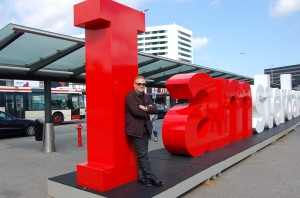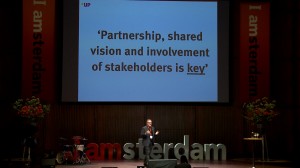July 4th, as we all know, is a rather special day. And for me its special for a couple of good reasons. Firstly its the day our colonial cousins mistakenly threw off the rule of mad King George and us British. It was an obvious mistake by the yanks as since then they have never managed to win anything at cricket and their football team, or soccer as they call it, is absolutely rubbish. Just think what they might have achieved. I write this knowing full well that a few of my American friends will respond with outrage at these remarks and want to correct my lack of appreciation and understanding of their own culture and what they call sports (these are generally activities that no one else in the world wants to play, so that they can declare themselves world champions).
Well, a good number of Americans also dont get irony too well either and I happen to understand the American mind rather well thanks to my American wife, who happens to be from the fine US state of Wisconsin.

Julian Stubbs. Positive to Amsterdam? Yes, I am
Which brings me to the second, and far more important reason that July 4th is a special day. It also happens to be my wedding anniversary. Yes, we were married on independence day. Now if that isnt irony enough for anyone call me Samuel Adams. Anyway, choosing July 4th as our wedding day seemed a good way of remembering the date and it seems to have worked up to now. Except today. Ive not forgotten the date, but Im not with my dear wife, but in Amsterdam. Yes, Amsterdam I hear you say.
Now Ive been in the Netherlands several times in the last few weeks. We have several Dutch clients and a highly active UP group here. Ive been down to Haarlem and run a masterclass in Place Branding, given speeches most recently at MARCOM 13 the main Dutch advertising symposium, as well as run Place Branding workshops, the last one being for the municipality of Utrecht.
Today Im in Amsterdam as a guest of the citys marketing group, the people behind the
I amsterdam brand. Ive been asked to give a speech to the citys marketing partners, around five hundred people, giving an assessment of how the
I amsterdam brand is really doing. Its an intriguing question and Amsterdam is an interesting and unusual place. But Ill come to that later.
Now, at UP we work with our Place Brand Scorecard covering the key categories when it comes to judging the important areas and assets that a place or destination has to offer or not. For the Amsterdam presentation we decided to concentrate on only a handful of the eighteen categories.
Identity
The
I amsterdam brand is one Ive always liked a lot. Its well crafted using strong colours and importantly it is highly visible just Google it. Look at the neat pictures you get of tourists posing with the physical 3D models of the logotype they have built around the city at various locations a way to bring the identity to life. The films Ive seen for the city using the new identity are also equally engaging and nowadays, as we all know, film is key in connecting quickly with an audience and delivering a complex message simply. The verbal identity for I amsterdam could be more developed but overall the identity work is very strong.

Julian Stubbs onstage at the Muziekgebouw, Amsterdam
Beginning in January 2013, Amsterdam has taken the important steps of merging its tourism and inward investment organisations into a single group. Now this is really important to get focus with a single organisation promoting the city brand. Its something Stockholm did early on, about the same time we launched
the Capital of Scandinavia brand so it had one united brand and identity being marketed by one organisation. Makes a lot of sense.
Planes, Trains and Automobiles (oh, and dont forget the ships)
One of the real strengths Amsterdam has is its incredible and I would even use the word enviable geographic location. It is really at the crossroads of Europe. This has given the city a fantastic infrastructure potential with Europes fourth busiest airport, Amsterdam Schiphol with over 50,000,000 passengers a year and with more than 120 intercontinental connections alone. Added to this they also have a really usable rail network. Now I know the Dutch complain about their rail network all the time and more about that little habit later but they should go and take the train in the UK or the US … then they would really have something to complain about.
Amsterdam also has a large and busy port, and on top of this, an extensive although heavily congested road network.
Importantly they are connected in another equally important way as well.
Digital Connectivity
One thing I look for, personally, in cities when I visit is great and free broadband access and Amsterdam is digitally turned on. At UP we depend on being online and having free access to digital where-ever we are and thankfully more and more places are falling in line with that mentality. Well Amsterdam is a really wired city. You get one hour free wi fi usage at the airport, my hotel had super fast, and free, wi fi and all this is powered by the Amsterdam Internet Exchange, AMSIX, making the Netherlands one of the most digitally connected places on earth. Now thats my kind of place.
Tourism Attractiveness
When it comes to being a tourist and having things to do, see and visit, I really like the choice on offer in Amsterdam. It has around 100 museums and more than 70 art galleries. Top of the list of museums is the recently re-opened and spectacular Rijksmuseum, with, not far behind, the Anne Frank House and Museum. The city also has great shops, restaurants and of course the coffee shops. Interestingly if you go in the coffee shops expecting to see locals puffing away, the only people in there seem to be foreign tourists. The city also has a large number of festivals, mostly with only a domestic audience focus, and it does seem like theres an opportunity to bring these festivals together under one umbrella and create a stronger, more international package. Look to Edinburgh I say.
The other thing I like about Amsterdam as a tourist is that its very walkable, you can really get around the centre on foot easily but if you do have to go a little further there are always the trams. High marks for tourism.
Architecture
We live and work most of our lives in buildings. Architecture can fundamentally affect how we feel about life and certainly our cities. Amsterdam has a really interesting mix when it comes to architecture with strong urban renewal redevelopment, an interesting but a rather eclectic mix of modern architecture, such as the
Muziekgebouw and the spectacular new film museum the
Eye Film Institute. And of course there is also classic Amsterdam with the canals and canal houses, dating back some four hundred years, and on a sunny day, when the sun is actually out, it is simply wonderful.

Julian Stubbs talking at the I amsterdam partner marketing day
So, Amsterdam has a lot going for it is everything perfect? Well, no. I believe they have some issues and one in particular. And its called positioning. What do they stand for? What slot in peoples brain does the Amsterdam brand hold?
In the July 2013 edition, the magazine Monocle ranked Amsterdam at number 22 in their Livable Cities benchmarking. Having listed the above assets the city has, as a result, Id say that was rather disappointing. Apart from some gripes about the quality of hotels and the time it took to renovate the Rijksmuseum the main issue Monocle had with Amsterdam was to do with the drugs laws. The magazine said: The now shelved plan to ban foreigners from buying cannabis should be revisited. It might hurt tourism in the short term but reform could give the city a chance to redefine itself on its merits as a beautiful, highly cultural urban space, In this remark I there is a clue as to the repositioning issue Amsterdam needs to consider.
Tulips to Prostitutes
And this brings me to my earlier remark that Amsterdam is an
unusual place. At UP we recently ran a focused piece of research on Amsterdam. We asked a small, but international sample of people, to answer one simple question. Use just one word to define Amsterdam.
Now what was interesting was that everyone asked wanted or needed to use more than a single word and, overall, the response was very consistent. They would mention either canals, bikes or tulips as one of the words but then also would want to mention drugs and or prostitution as a second word. And thats what makes Amsterdam unusual. This mental mix of things that the city stands for. Everything from tulips to prostitutes. Again an eclectic mix.
Re-positioning. The Stockholm example.
In my mind, Amsterdam needs to consider how it wants to re-define or re-position itself. The city needs to take real action to change its image by either making real changes when it comes to the issues of drugs and prostitution, or they need to reposition themselves in a way that embraces their free and open culture and creates a larger, even stronger proposition in peoples minds. Not easy stuff, but the choice is theirs to make.
When we worked on the Stockholm branding work, back in 2003, we quickly concluded, based on the research available, that Stockholm needed to find a focus. Some way of finding a position for itself.
Stockholm is one of the most beautiful cities on earth but that alone is not enough there are plenty of beautiful cities in the world.
The city had marketed itself in the past but had chopped and changed its focus. One moment it was all about ITC, the next it was saying it was Venice of the North, or Gateway to the Baltic Sea Region. The brand lacked consistency and persistence.
After taking in the various inputs from the research we had, the moment came where we had to start to draw some conclusions. First, we had to decide how we wanted to position Stockholm in the marketplace we were competing in and secondly, decide on what our business proposition would be.
Such business propositions dont need to be long wordy documents, in fact, they are better short and concise, and
preferably able to be written on the back of a napkin which is exactly what we did.
For Stockholm the proposition we felt was simply that it was the most important place in Scandinavia. For business and for tourism.
Once that idea had been anchored, it was just a case of delivering a creative execution of that proposition to bring it to life in a nano second.
Stockholm the Capital of Scandinavia was born.
The moment the line had been written it resonated. It was bold, simple and just a little provocative or Kaxig as they say in Sweden. Everything a strong, creative, brand idea should be.
Amsterdam
Amsterdam needs to consider something equally strong to really move the discussion on from hash and hookers. It has a strong tradition and culture of freedom and the discussion and thinking should probably start there. One interesting observation, I’ve always seen the Swedes and Dutch as sharing many characteristics and traditions. Both have very free and open societies, both would be classified as liberal and yet on the subject of prostitution they could not be further apart in their viewpoints.
A couple of additional observations regarding Amsterdam. I think a good deal more focus needs to be put on working internally with the people of Amsterdam themselves. An effort needs to be made to make them realise just what a great city Amsterdam is. I think its in the Dutch character to complain a bit, but I think they also need to shake off their protestant burden of not wanting to appear to be too good or stand out too much or be too proud of their city (this is very similar to the Swedish
Jantelagen and Norwegian
Janteloven in this respect).
Service is also an area where they seem to be a bit lacking. Im not sure there is a true service mentality in the culture and that needs to be looked at when the positioning work is really examined. Where do they want to pitch Amsterdam in the future? Is it a backpackers paradise with budget hotels and Airbnb accommodation, with coffee shops providing a place to puff, or is it a more upmarket high value destination?
I like Amsterdam a lot. It has a huge number of assets. It has personality and, importantly, a feel of authenticity. Im glad I was here the 4th of July I just sent a message to my wife saying, Darling
Wish You Were Here.
Am I positive to Amsterdam? Yes, I am.
—————————————————————————-
Julian Stubbs is an international brand strategist with UP THERE, EVERYWHERE, the global cloud based agency. He primarily works with cities, places and destinations in developing brand strategies and identities. His first book,
Wish You Were Here is available on Amazon.com